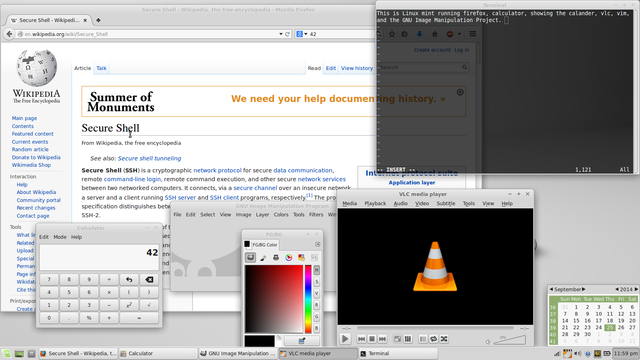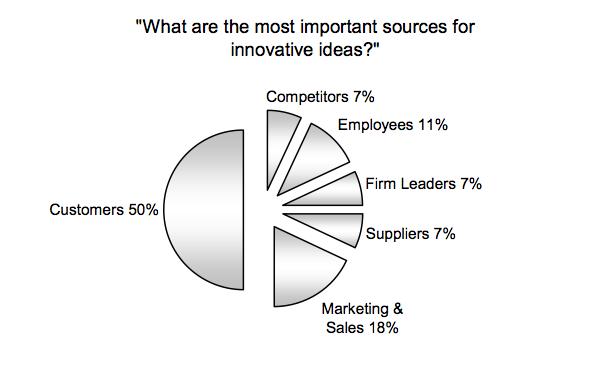The digital era has seen the emergence of many new business and technological paradigms. Digital and online technologies are changing the way interact and do business. We’ve got more ways for companies and clients to connect with one another, and we’ve got more new channels for accessing goods and services than ever before. We’re also seeing entirely new strategies for managing innovation and creativity within companies and without.
The ability for people to work remotely using the Internet along with the proliferation of tools like CAD design and 3D printing means that independent product designers now have tons of creative potential. This is a tremendous resource for firms that are willing to harness it.
While outsourcing tasks to external agents has been around forever, what we’re seeing now more than ever is companies not just sending out requests for labor, but sending out requests for ideas. It turns out that opening up to outsider contributions is good for creativity and good for business. This new paradigm is called Open Innovation, and it can result in better products and increased revenues.
What is Open Innovation?
At its most basic, open innovation is a paradigm for businesses which says that companies can and should take advantage of ideas both from inside their own organizations and from outside sources. This includes looking at outside paths to market, where applicable. In other words, it’s about opening up product design and development to participation from external partners and stakeholders. It’s a way for firms to actively incorporate the wider community into their innovation management strategy.
By partnering up with individuals and organizations outside its own internal network, companies are distributing both the risks and the rewards of new development. Open innovation usually involves some kind of benefit for the external contributors, while also lessening the responsibilities on the firm as the sole driver of creativity. Thus risk and benefits are shared more widely.
But open innovation isn’t just about hedging bets or reducing financial risk — not by a long shot! The primary and central idea at the heart of this new paradigm is that this kind of distributed innovative networking actually produces better ideas. And better ideas means better products, and thus higher profits. By opening up to voices that might not otherwise be heard, better, more creative and more efficient solutions to problems can be realized.

Software people may notice some striking similarities behind this philosophy and the open source movement. The two philosophies do share a lot in common. Proponents of open source software believe that releasing source code so that it can viewed and edited by anyone results in better, more secure software than the traditional proprietary approach to coding. The proliferation of open source projects ranging from VLC media player to Mozilla Firefox to Android smartphones (which run on Linux) and even projects like Wikipedia suggests that there is some validity to this idea. However, the open innovation paradigm does not share the open source rejection of patents and exclusive IP. While there are different open innovation strategies (see below), most of them involve the host company maintaining control over the design process and the final product.
Both open source and open innovation are successful because they recognize the distributed nature of knowledge and information — particularly in this digital age. The amount of information that exists out there now is just so incredibly vast and spread out that no individual, corporation, or institution can rely solely on their own private knowledge and still be competitive.
Collectively, humanity has amassed an unbelievable store of knowledge and experience. But individually, not even the most decorated post-docs really can know all there is to know, even about a given a subject. It is exactly this kind of distributed collective information network that open innovation recognizes and seeks to leverage for better products and higher profits. Any company that wants to be competitive should be willing to look for innovations coming from outside and should facilitate that transfer of knowledge. For their own sake, and for the sake of furthering human ingenuity.
Crowdsourcing, Outsourcing, and Open Innovation
So, open innovation is a pretty broad idea. And it’s not totally new. Companies have always turned to outsiders for help, either by teaming up with other firms for R&D purposes or by licensing products from independent inventors. What’s new today though is the extent to which this kind of two-way flow of ideas can be realized.
Outsourcing is usually what people think about when they think about firms soliciting external agents. Outsourcing can be part of an open innovation strategy, depending on the kind of work being outsourced. Outsourcing data entry jobs or manufacturing services doesn’t exactly involve a two-way transfer of ideas and information. But bringing in external designers to help develop ideas into viable products sure does.
Crowdsourcing is sometimes regarded as being separate from open innovation, but it might be more properly regarded as a particular kind of open innovation strategy. There are many different kinds of crowdsourcing, but the primary thing that ties them all together is this concept of an open call for contributions from the community. This seems like a prime example of open innovation at work.
innovation, but it might be more properly regarded as a particular kind of open innovation strategy. There are many different kinds of crowdsourcing, but the primary thing that ties them all together is this concept of an open call for contributions from the community. This seems like a prime example of open innovation at work.
Crowdsourced design challenges, like those that we run on Cad Crowd, are a kind of crowdsourcing that asks contributors to provide different competing solutions to a design problem. Unlike working with an in-house design team or hiring a design firm, this strategy produces a whole range of different solutions proposed by people with varying skill sets, histories, and backgrounds. As such, a contest has the potential to produce some truly novel and creative solutions to problems that might be very different from what the host company expected. Even if some of the more outside the box ideas aren’t ultimately selected, they can be a welcome source of inspiration for other designers and for the host company. And this exchange goes both ways: the designers who participate in the contest are let in a little to what the host company is working on, and they get to see the alternative solutions proposed by other competitors.
Of course, this isn’t the only way to use networked technology to appeal to the crowd for innovation. Crowdsourcing often involves asking users or customers to contribute to a product which they themselves use. This can take the form of projects like Wikipedia or OpenStreetMap which rely on user-generated data or content. It can also involve asking customers for ideas about how a product should be developed, and this is of great potential value to companies.

Push and Pull Innovation
In business parlance, there are two major categories of innovation: push and pull. Technology-push innovation is the term for when a product is brought to market for which there was no pre-existing demand. This is the rarer kind of innovation, and you find it in contexts where a firm is developing a product or service which hasn’t really existed before, usually centered around a new kind of technology.
The Sony Walkman and the Apple iPad are good examples of push innovation. Prior to the release of either of those products, the market was not really clamoring for portable music players or tablet computers. Uber is also a good candidate, since prior to its emergence on the scene there was no real market demand for a ride-hailing app, since no such thing had ever existed. People weren’t asking for it because it wasn’t a thing yet.
So, it is possible for companies to do very well with push innovation. Sometimes these kinds of products or services that enter the market without much precedent are referred to as ‘disruptors’ and can, like in the case of Uber, rapidly develop into extremely profitable enterprises. However, there are also numerous cases, such as the infamous Dvorak keyboard layout, that show that inventions will often fail unless they are addressing an existing market need.
This is where market-pull innovation steps in. Pull innovation is when a company responds to market demands and creates a product or service that customers are asking for. Generally, this strategy is a more reliable way to design profitable and successful products because you can predict that people will want to buy the thing that they say they want.
Open innovation can benefit both pull and push strategies, but it really shines when it comes to pull. Crowdsourcing and other forms of open innovation that actively seek input from the wider customer base are a great way for designers and developers to learn what exactly the market is calling for, allowing them to cater their product or services specifically to the needs of their customers.
The open innovation paradigm is centered around the concept that outside information helps to drive good design. What better source of information could there be for during a market-pull design than the customers themselves? Users often know exactly what it is they want from the products and services they use regularly. And now businesses have the technological tools that allow them easily to ask for and receive input and ideas from their users. That’s open innovation in action.
Open Innovation Strategies
There is a wide range of different strategies that a firm can pursue in order to leverage the power of open innovation to increase profits and deliver successful products.
Design Contests/Idea Competitions: As mentioned above, one increasingly popular way for firms to take advantage of open innovation is through design challenges that offer some kind of reward for successful submissions. On Cad Crowd we always have a number of ongoing contests that have ranged from custom medical device design to smartphone designs to robotic lawnmowers (see the design above).
Product Platforming: This is a model of open innovation in which a company releases a partially developed product and invites the community to participate in further developments. This model is particularly common in software, where companies will release software development kits (SDK) or application programming interfaces (API) for the community to build upon. The things that get built usually end up benefiting the host company, since they are meant to operate on their platforms (think of iPhone apps), but they aren’t really in control of the final product.
Customer Immersion: This strategy involves developing a product far enough along that it can be introduced to consumers. Then, the company brings in those consumers for extensive consultations and focus testing on the product in order to gain direction on how the development should continue. This is more immersive and interactive than conventional focus groups, which are looking more to gauge reactions than to solicit advice and ideas.
Collaborative Product Development: In this product design strategy, collaborators are brought in to contribute to the development of the product. This method differs from platforming in that the host company maintains control and ownership of the product throughout its development, rather than releasing a framework and allowing the community of contributors to take it from there.
Open innovation is flexible, and different strategies will work better for different businesses and for different kinds of products. Firms should attempt to find the avenue that works best for them, and to strike the proper balance between openness and ownership. Open innovation is not the only design paradigm out there, and it might not be appropriate for every context. But it is an exciting new method that promises great returns when executed well by forward-thinking firms and entrepreneurs.
Whether you’re interested in outsourcing, crowdsourcing, or open innovation, Cad Crowd is here to help! We specialize in connect innovators and entrepreneurs with the best freelance design services on the net, and we also host design challenges. Learn more!
